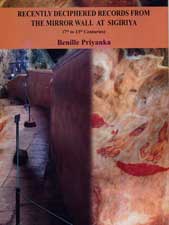A hardly noticed landmark event in Sri Lanka’s scholarly world took place at the Archaeological Department in the first week of August: the launch of Benille Priyanka’s book on the decipherment of almost all the ‘visible’ but unread graffiti on the Mirror Wall at Sigiriya.
Priyanka’s publication of 800 hitherto unread records on the Mirror Wall is a dramatic and unprecedented expansion of the monumental work on the graffiti by Senarat Paranavitana, one of the founding spirits of Sri Lankan archaeology and epigraphy. Paranavitana’s Sigiri Graffiti; being Sinhalese Verses of the Eighth, Ninth and Tenth Centuries was published in two massive volumes by the Oxford University Press for the government of Ceylon, in that iconic year 1956. Its publication was an extraordinary event, a landmark in the evolving intellectual and cultural landscape of post-Independence Sri Lanka.
 |
Although it was known that there were scrawled ancient graffiti on the Mirror Wall and elsewhere at Sigiriya, and attempts at reading a few writings had been made by H.C.P. Bell in 1905, there had been no real recognition of their character or significance. Prof. Paranavitana’s decipherment, transliteration and translation opened a window to a historical world that until then had been almost unknown. It was a world of public voices – one is tempted to say a world that encompassed ‘carpenters and kings’ but for the fact that the sociology and historiographical implications of the Sigiriya texts have not been yet been seriously addressed.
Dr. Priyanka has now made that possible in a more comprehensive way than before. He has furthered Paranavitana’s pioneering achievement by recording almost the entire body of readable graffiti writings that were previously undeciphered. This constitutes a formidable task which no other scholar attempted in the half century since Paranavitana’s 1956 publication. Reading directly from the Mirror Wall itself, rather than from rubbings, Priyanka spent exhausting months of effort in the field working on his decipherments.
He estimates that there are a total of about 1800 records on the Mirror Wall of which nearly 1500 (685 by Paranavitana and 800 by Priyanka) have now been deciphered and published. Moreover, Priyanka presents eye-copies of more than 500 of the 800 newly deciphered texts, and gives exact coordinates on the wall for all his readings, so that other specialists may independently check his interpretations. He observes that approximately 300 extremely fragmentary or badly weatherworn texts still remain to be read and recorded. The earliest graffiti he publishes are three records from the 6th/7th century, while the latest are 45 records from the Polonnaruva and Dambadeniya Periods, 11th to 13th centuries, and at least one text, a Sanskrit stanza, from the 14th or 15th century. The majority of records date from the 8th to 10th centuries, the last phase of the Anuradhapura Period. Priyanka also notes five records in Tamil or ‘unknown’ scripts, five graffiti written in ink and a single record incised on the paintings in the ‘Fresco Pocket’.
By his near complete reading of the surviving and decipherable graffiti, Priyanka makes it possible to see the Mirror Wall writings (as well as the few graffiti in the rock-shelters of the Boulder Garden) almost in their entirety. We now have a more comprehensive and diachronic view of the individual thoughts, feelings and emotions of hundreds of visitors to the remains of the historic palace and city site of Sigiriya over a time span of more than 800 years, from the 6th century onwards. Although the book has no index it has 11 analytical appendices and a detailed list of contents that allows the reader to find his or her way easily in its 696 pages.
For archaeologists and historians the graffiti readings constitute an amazing set of documents. Not only do they provide an invaluable source for contextualising and interpreting the material remains at the site, they are also a unique example of ‘proto-archaeological’ perspectives in historical times, revealing the personal responses of visitors to the ruins and surviving art works at an ancient royal and urban complex. The Sigiri graffiti contain the earliest poetry in Sinhala. Priyanka has also identified early prose passages in the Mirror Wall texts. The largest number of records is verses addressed to the female figures depicted on the rock face, ‘poems about paintings, art about art’.
One hopes that linguistic and literary studies, and contemporary Sri Lankan writing, will have a significant impetus from the publication of these rare early records. Moreover, the potential for social history and the study of the cognitive landscape of the society of the Middle Historical Period (6th to 13th centuries) from these records has barely been touched. Dr Priyanka’s book, taken together with Prof. Paranavitana’s classic volumes, now makes it possible to maximize the resources we have from the Mirror Wall to deepen our understanding of the society of those times. |


